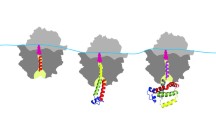Abstract
Recent research on the quantum chemistry of the amino acids and on the temporal order of their ancient introduction into the genetic code has yielded the surprising finding that the amino acids have become system-atically softer (i. a. meaning more redox reactive) during evolution. This trend is recapitulated by recent innovations in organelle genetic codes found in present-day animals. Thus, aspects of chemical reactivity rather than three-dimensional structure optimization governed the finalization of the modern genetic code.
Similar content being viewed by others
Literatur
Koonin EV, Novozhilov AS (2009) Origin and evolution of the genetic code: the universal enigma. IUBMB Life 61:99–111
Longo LM, Blaber M (2012) Protein design at the interface of the pre-biotic and biotic worlds. Arch Biochem Biophys 526:16–21
Trifonov EN (2009) The origin of the genetic code and of the earliest oligopeptides. Res Microbiol 160:481–486
Granold M (2015) Die Bedeutung von molekularem Sauerstoff für die Evolution des genetischen Codes. Dissertation, Universität Mainz
Bender A, Hajieva P, Moosmann B (2008) Adaptive antioxidant methionine accumulation in respiratory chain complexes explains the use of a deviant genetic code in mitochondria. Proc Natl Acad Sci USA 105:16496–16501
Schindeldecker M, Moosmann B (2015) Protein-borne methionine residues as structural antioxidants in mitochondria. Amino Acids 47:1421–1432
Levine RL, Mosoni L, Berlett BS et al. (1996) Methionine residues as endogenous antioxidants in proteins. Proc Natl Acad Sci USA 93:15036–15040
Gray HB, Winkler JR (2015) Hole hopping through tyrosine/tryptophan chains protects proteins from oxidative damage. Proc Natl Acad Sci USA 112:10920–10925
Hajieva P, Bayatti N, Granold M et al. (2015) Membrane protein oxidation determines neuronal degeneration. J Neurochem 133:352–367
Lyons TW, Reinhard CT, Planavsky NJ (2014) The rise of oxygen in Earth’s early ocean and atmosphere. Nature 506:307–315
Yang XL, Otero FJ, Skene RJ et al. (2003) Crystal structures that suggest late development of genetic code components for differentiating aromatic side chains. Proc Natl Acad Sci USA 100:15376–15380
Jones TE, Ribas de Pouplana L, Alexander RW (2013) Evidence for late resolution of the AUX codon box in evolution. J Biol Chem 288:19625–19632
Author information
Authors and Affiliations
Corresponding author
Additional information
Bernd Moosmann Jahrgang 1973. 1992–1998 Studium an der LMU München und der FU Berlin. 1998–2002 Promotionsarbeit am Max-Planck-Institut für Psychiatrie in München. 2002–2004 Postdoktorand am Burnham Institute in La Jolla, CA, USA. 2004–2010 Juniorprofessor, seit 2010 Universitätsprofessor an der Universitätsmedizin der Universität Mainz.
Rights and permissions
About this article
Cite this article
Moosmann, B. Redoxbiochemie des genetischen Codes. Biospektrum 23, 748–751 (2017). https://doi.org/10.1007/s12268-017-0864-7
Published:
Issue Date:
DOI: https://doi.org/10.1007/s12268-017-0864-7




